Speco Technologies CS4, CS8 User Manual

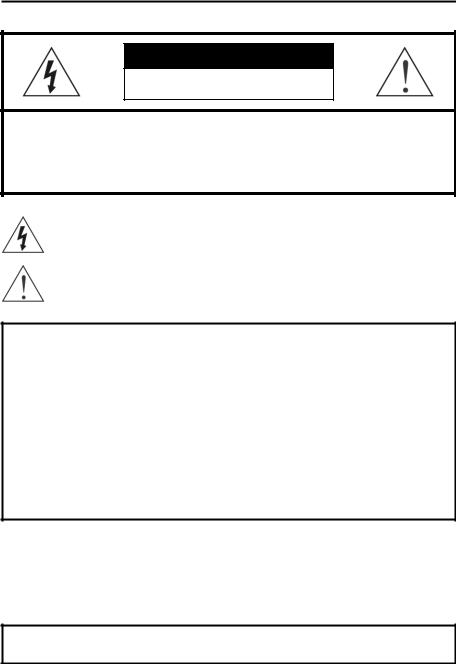
4- & 8- Channel Digital Video Recorder
WARNING
RISK OF ELECTRIC SHOCK
DO NOT OPEN
WARNING: TO REDUCE THE RISK OF ELECTRIC SHOCK,
DO NOT REMOVE COVER (OR BACK).
NO USER-SERVICEABLE PARTS INSIDE.
REFER SERVICING TO QUALIFIED
SERVICE PERSONNEL.
The lightning flash with arrowhead symbol, within an equilateral triangle, is intended to alert the user to the presence of uninsulated "dangerous voltage" within the product’s enclosure that may be of sufficient magnitude to constitute a risk of electric shock.
The exclamation point within an equilateral triangle is intended to alert the user to the presence of important operating and maintenance (servicing) instructions in the literature accompanying the appliance.
COMPLIANCE NOTICE OF FCC:
THIS EQUIPMENT HAS BEEN TESTED AND FOUND TO COMPLY WITH THE LIMITS FOR A CLASS A DIGITAL DEVICE, PURSUANT TO PART 15 OF THE FCC RULES. THESE LIMITS ARE DESIGNED TO PROVIDE REASONABLE PROTECTION AGAINST HARMFUL INTERFERENCE WHEN THE EQUIPMENT IS OPERATED IN A COMMERCIAL ENVIRONMENT. THIS EQUIPMENT GENERATES, USES, AND CAN RADIATE RADIO FREQUENCY ENERGY AND IF NOT INSTALLED AND USED IN ACCORDANCE WITH THE INSTRUCTION MANUAL, MAY CAUSE HARMFUL INTERFERENCE TO RADIO COMMUNICATIONS. OPERATION OF THIS EQUIPMENT IN A RESIDENTIAL AREA IS LIKELY TO CAUSE HARMFUL INTERFERENCE, IN WHICH CASE USERS WILL BE REQUIRED TO CORRECT THE INTERFERENCE AT THEIR OWN EXPENSE.
WARNING: CHANGES OR MODIFICATIONS NOT EXPRESSLY APPROVED BY THE PARTY RESPONSIBLE FOR COMPLIANCE COULD VOID THE USER’S AUTHORITY TO OPERATE THE EQUIPMENT.
THIS CLASS OF DIGITAL APPARATUS MEETS ALL REQUIREMENTS OF THE CANADIAN INTERFERENCECAUSING EQUIPMENT REGULATIONS.
The information in this manual is believed to be accurate as of the date of publication. We are not responsible for any problems resulting from the use thereof. The information contained herein is subject to change without notice. Revisions or new editions to this publication may be issued to incorporate such changes.
The software included in this product contains some Open Sources. You may obtain the complete corresponding source code from us. See the Open Source Guide on the software CD (OpenSourceGuide\OpenSourceGuide.pdf) or as a printed document included along with the User's Manual.
i
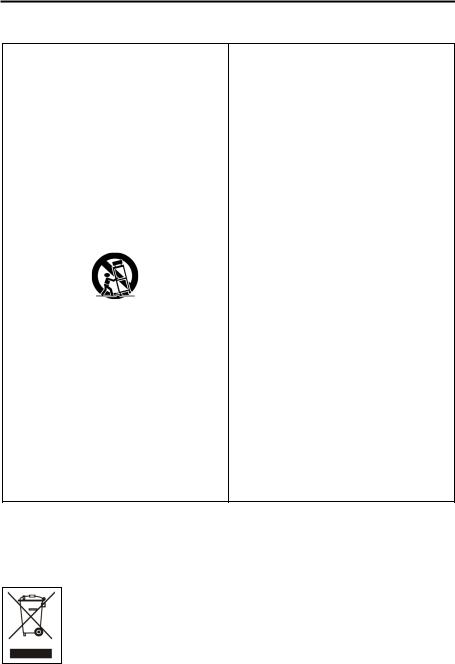
Operation Instruction
Important Safeguards
1. Read Instructions
All the safety and operating instructions should be read before the appliance is operated.
2. Retain Instructions
The safety and operating instructions should be retained for future reference.
3. Cleaning
Unplug this equipment from the wall outlet before cleaning it. Do not use liquid aerosol cleaners. Use a damp soft cloth for cleaning.
4. Attachments
Never add any attachments and/or equipment without the approval of the manufacturer as such additions may result in the risk of fire, electric shock or other personal injury.
5. Water and/or Moisture
Do not use this equipment near water or in contact with water.
6. Placement and Accessories
Do not place this equipment on an unstable cart, stand or table. The equipment may fall, causing serious injury to a child or adult, and serious damage to the equipment.
This equipment and cart combination should be moved with care. Quick stops, excessive force, and uneven surfaces may cause the equipment and cart combination to overturn.
Do not place this equipment on a closed space. Sufficient amount of ventilation air is necessary to avoid increase of ambient temperature which can cause improper operation or the risk of fire.
7. Power Sources
This equipment should be operated only from the type of power source indicated on the marking label. If you are not sure of the type of power, please consult your equipment dealer or local power company.
8. Power Cords
Operator or installer must remove power and TNT connections before handling the equipment.
9. Lightning
For added protection for this equipment during a lightning storm, or when it is left unattended and unused for long periods of time, unplug it from the wall outlet and disconnect the antenna or cable system. This will prevent damage to the equipment due to lightning and power-line surges.
10. Overloading
Do not overload wall outlets and extension cords as this can result in the risk of fire or electric shock.
11. Objects and Liquids
Never push objects of any kind through openings of this equipment as they may touch dangerous voltage points or short out parts that could result in a fire or electric shock. Never spill liquid of any kind on the equipment.
12. Servicing
Do not attempt to service this equipment yourself. Refer all servicing to qualified service personnel.
13. Damage requiring Service
Unplug this equipment from the wall outlet and refer servicing to qualified service personnel under the following conditions:
A.When the power-supply cord or the plug has been damaged.
B.If liquid is spilled, or objects have fallen into the equipment.
C.If the equipment has been exposed to rain or water.
D.If the equipment does not operate normally by following the operating instructions, adjust only those controls that are covered by the operating instructions as an improper adjustment of other controls may result in damage and will often require extensive work by a qualified technician to restore the equipment to its normal operation.
E.If the equipment has been dropped, or the cabinet damaged.
F.When the equipment exhibits a distinct change in performance – this indicates a need for service.
14. Replacement Parts
When replacement parts are required, be sure the service technician has used replacement parts specified by the manufacturer or that have the same characteristics as the original part. Unauthorized substitutions may result in fire, electric shock or other hazards.
15. Safety Check
Upon completion of any service or repairs to this equipment, ask the service technician to perform safety checks to determine that the equipment is in proper operating condition.
16. Field Installation
This installation should be made by a qualified service person and should conform to all local codes.
17. Correct Batteries
Warning: Risk of explosion if battery is replaced by an incorrect type. Dispose of used batteries according to the instructions.
18. Tmra
A manufacturer’s maximum recommended ambient temperature (Tmra) for the equipment must be specified so that the customer and installer may determine a suitable maximum operating environment for the equipment.
WEEE (Waste Electrical & Electronic Equipment)
Correct Disposal of This Product
(Applicable in the European Union and other European countries with separate collection systems)
This marking shown on the product or its literature, indicates that it should not be disposed with other household wastes at the end of its working life. To prevent possible harm to the environment or human health from uncontrolled waste disposal, please separate this from other types of wastes and recycle it responsibly to promote the sustainable reuse of material resources.
Household users should contact either the retailer where they purchased this product, or their local government office, for details of where and how they can take this item for environmentally safe recycling.
Business users should contact their supplier and check the terms and conditions of the purchase contract. This product should not be mixed with other commercial wastes for disposal.
ii

|
4- & 8- Channel Digital Video Recorder |
|
Table of Contents |
Chapter 1 ─ Introduction ................................................................................................ |
1 |
Features...................................................................................................................... |
1 |
Technical Overview.................................................................................................... |
1 |
Chapter 2 ─ Installation.................................................................................................. |
3 |
Package Contents ...................................................................................................... |
3 |
Required Installation Tools......................................................................................... |
3 |
Video Input ............................................................................................................. |
3 |
Audio In/Out............................................................................................................ |
4 |
Factory Reset Switch ............................................................................................. |
4 |
Video Out................................................................................................................ |
4 |
Network Port........................................................................................................... |
4 |
Alarm Input/Output ................................................................................................. |
5 |
RS485 Port ............................................................................................................. |
5 |
RS232 Port ............................................................................................................. |
5 |
Power Cord Connector........................................................................................... |
6 |
Chapter 3 ─ Configuration ............................................................................................. |
7 |
Front Panel Controls .................................................................................................. |
7 |
Menu Button ........................................................................................................... |
7 |
Copy Button............................................................................................................ |
8 |
Esc Button .............................................................................................................. |
8 |
Play/Stop Button..................................................................................................... |
8 |
Camera Buttons ..................................................................................................... |
8 |
Arrow Buttons......................................................................................................... |
8 |
Play/Pause Button.................................................................................................. |
8 |
HDD LED................................................................................................................ |
8 |
Power LED ............................................................................................................. |
9 |
USB Port................................................................................................................. |
9 |
Remote Control Buttons............................................................................................. |
9 |
ID Button............................................................................................................... |
10 |
Camera Buttons ................................................................................................... |
10 |
Sequence Button.................................................................................................. |
10 |
Login/Logout Button ............................................................................................. |
10 |
Arrow Buttons....................................................................................................... |
10 |
Menu Button ......................................................................................................... |
10 |
Playback Buttons.................................................................................................. |
10 |
Alarm Button......................................................................................................... |
11 |
Layout Button ....................................................................................................... |
11 |
Zoom Button ......................................................................................................... |
11 |
PTZ Button ........................................................................................................... |
11 |
Enter Button.......................................................................................................... |
11 |
Esc Button ............................................................................................................ |
11 |
PTZ Control Buttons............................................................................................. |
11 |
iii

Operation Instruction
Copy Button.......................................................................................................... |
11 |
Play/Stop Button................................................................................................... |
12 |
Turning on the Power............................................................................................... |
12 |
Initial Unit Setup ....................................................................................................... |
12 |
Setup Screen............................................................................................................ |
13 |
System Setup ........................................................................................................... |
14 |
Information............................................................................................................ |
14 |
Date/Time ............................................................................................................. |
16 |
Storage ................................................................................................................. |
17 |
User ...................................................................................................................... |
19 |
EZ Setup............................................................................................................... |
21 |
Shutdown.............................................................................................................. |
25 |
Recording Setup....................................................................................................... |
25 |
Record .................................................................................................................. |
25 |
Schedule............................................................................................................... |
27 |
Pre-Event.............................................................................................................. |
29 |
Event Setup .............................................................................................................. |
30 |
Alarm-In ................................................................................................................ |
30 |
Motion Detection .................................................................................................. |
32 |
Video Loss............................................................................................................ |
34 |
Video Blind ........................................................................................................... |
35 |
Text-In................................................................................................................... |
37 |
System Event ....................................................................................................... |
39 |
Event Status ......................................................................................................... |
41 |
Network Setup.......................................................................................................... |
42 |
Network................................................................................................................. |
42 |
Notification............................................................................................................ |
47 |
Devices Setup .......................................................................................................... |
50 |
Camera................................................................................................................. |
50 |
Audio..................................................................................................................... |
52 |
Alarm-Out ............................................................................................................. |
52 |
Digital Deterrent ................................................................................................... |
53 |
Display.................................................................................................................. |
55 |
Remote Control .................................................................................................... |
57 |
Chapter 4 ─ Operation ................................................................................................. |
59 |
Turning on the Power............................................................................................... |
59 |
Live Monitoring ......................................................................................................... |
59 |
Live Monitoring Menu ........................................................................................... |
60 |
Active Cameo Mode ............................................................................................. |
62 |
Zoom Mode .......................................................................................................... |
63 |
Event Monitoring .................................................................................................. |
63 |
Covert Camera ..................................................................................................... |
63 |
PTZ Mode............................................................................................................. |
63 |
Recording Video....................................................................................................... |
65 |
Recording Audio....................................................................................................... |
65 |
iv

4- & 8- Channel Digital Video Recorder |
|
Playing Recorded Video........................................................................................... |
65 |
Searching Video ....................................................................................................... |
66 |
Search Menu ........................................................................................................ |
67 |
Event Log Search................................................................................................. |
69 |
Record Table Search ........................................................................................... |
71 |
Motion Search ...................................................................................................... |
72 |
Text-In Search...................................................................................................... |
74 |
Clip-Copy.............................................................................................................. |
75 |
Appendix....................................................................................................................... |
77 |
USB Hard Disk Drive Preparation............................................................................ |
77 |
Preparing the USB hard disk drive in Windows 2000.......................................... |
77 |
Preparing the USB hard disk drive in Windows 98.............................................. |
77 |
Text-In Search Examples......................................................................................... |
78 |
Search Example I ................................................................................................. |
78 |
Search Example II ................................................................................................ |
79 |
Speco Remote.......................................................................................................... |
79 |
Web Monitoring Mode .......................................................................................... |
81 |
Web Search Mode................................................................................................ |
82 |
System Log Notices ................................................................................................. |
84 |
Error Code Notices................................................................................................... |
85 |
Troubleshooting........................................................................................................ |
85 |
Map of Screens ........................................................................................................ |
86 |
Specifications ........................................................................................................... |
87 |
v

Operation Instruction
List of Illustrations |
|
Figure 1 ─ Typical DVR installation. ......................................................................................... |
2 |
Figure 2 ─ 8-Channel DVR rear panel...................................................................................... |
3 |
Figure 3 ─ DVR front panel. ..................................................................................................... |
7 |
Figure 4 ─ Infrared remote control............................................................................................ |
9 |
Figure 5 ─ Login screen. ........................................................................................................ |
12 |
Figure 6 ─ Logout screen. ...................................................................................................... |
13 |
Figure 7 ─ Setup screen......................................................................................................... |
13 |
Figure 8 ─ System menu........................................................................................................ |
14 |
Figure 9 ─ Information setup screen. ..................................................................................... |
14 |
Figure 10 ─ Date/Time setup screen...................................................................................... |
16 |
Figure 11 ─ Holiday setup screen. ......................................................................................... |
17 |
Figure 12 ─ Time Sync. setup screen. ................................................................................... |
17 |
Figure 13 ─ Storage Information setup screen. ...................................................................... |
18 |
Figure 14 ─ Storage Status setup screen............................................................................... |
19 |
Figure 15 ─ User setup screen............................................................................................... |
19 |
Figure 16 ─ EZ Setup screen. ................................................................................................ |
21 |
Figure 17 ─ EZ Record screen............................................................................................... |
22 |
Figure 18 ─ EZ Network screen. ............................................................................................ |
23 |
Figure 19 ─ Shutdown screen. ............................................................................................... |
25 |
Figure 20 ─ Record menu. ..................................................................................................... |
25 |
Figure 21 ─ Record setup screen........................................................................................... |
25 |
Figure 22 ─ Panic Record setup screen................................................................................. |
27 |
Figure 23 ─ Schedule setup screen. ...................................................................................... |
27 |
Figure 24 ─ Schedule – Settings (Advanced Mode) setup screen.......................................... |
28 |
Figure 25 ─ Pre-Event setup screen. ..................................................................................... |
29 |
Figure 26 ─ Event menu......................................................................................................... |
30 |
Figure 27 ─ Alarm-In Settings setup screen. .......................................................................... |
30 |
Figure 28 ─ Alarm-In Actions 1 setup screen. ........................................................................ |
31 |
Figure 29 ─ Alarm-In Actions 2 setup screen. ........................................................................ |
31 |
Figure 30 ─ Motion Detection Settings setup screen. .............................................................. |
32 |
Figure 31 ─ Motion Detection Actions 1 setup screen. ........................................................... |
33 |
Figure 32 ─ Motion Detection Actions 2 setup screen. ........................................................... |
34 |
Figure 33 ─ Video Loss Settings setup screen....................................................................... |
34 |
Figure 34 ─ Video Loss Actions setup screen. ....................................................................... |
35 |
Figure 35 ─ Video Blind Settings setup screen. ..................................................................... |
36 |
Figure 36 ─ Video Blind Actions setup screen........................................................................ |
36 |
Figure 37 ─ Text-In Settings setup screen. ............................................................................ |
37 |
Figure 38 ─ Text-In Device setup screen. .............................................................................. |
37 |
Figure 39 ─ Text-In Actions setup screen............................................................................... |
39 |
Figure 40 ─ Health Check setup screen................................................................................. |
40 |
Figure 41 ─ Storage setup screen.......................................................................................... |
40 |
Figure 42 ─ System Event Actions setup screen.................................................................... |
41 |
Figure 43 ─ Event Status setup screen. ................................................................................. |
42 |
Figure 44 ─ Network menu..................................................................................................... |
42 |
Figure 45 ─ Network setup screen. ........................................................................................ |
43 |
Figure 46 ─ LAN (Manual) setup screen. ............................................................................... |
44 |
Figure 47 ─ DVRNS setup screen.......................................................................................... |
45 |
Figure 48 ─ RTSP setup screen............................................................................................. |
46 |
vi

|
4- & 8- Channel Digital Video Recorder |
Figure 49 ─ Speco Remote setup screen............................................................................... |
47 |
Figure 50 ─ Notification Callback setup screen. ..................................................................... |
47 |
Figure 51 ─ Notification Mail setup screen. ............................................................................ |
48 |
Figure 52 ─ Notification SNS setup screen. ........................................................................... |
49 |
Figure 53 ─ Notification Schedule setup screen..................................................................... |
50 |
Figure 54 ─ Devices menu. .................................................................................................... |
50 |
Figure 55 ─ Camera setup screen.......................................................................................... |
51 |
Figure 56 ─ Camera PTZ setup screen.................................................................................. |
51 |
Figure 57 ─ Audio setup screen. ............................................................................................ |
52 |
Figure 58 ─ Alarm-Out Settings setup screen. ....................................................................... |
52 |
Figure 59 ─ Alarm-Out Schedule setup screen. ..................................................................... |
53 |
Figure 60 ─ Digital Deterrent setup screen............................................................................. |
53 |
Figure 61 ─ Display OSD setup screen.................................................................................. |
55 |
Figure 62 ─ Main Monitor setup screen.................................................................................. |
56 |
Figure 63 ─ VGA setup screen............................................................................................... |
56 |
Figure 64 ─ Remote Control setup screen. ............................................................................ |
57 |
Figure 65 ─ Live Monitoring menu.......................................................................................... |
59 |
Figure 66 ─ PTZ Select Camera menu. ................................................................................. |
64 |
Figure 67 ─ PTZ Preset screen.............................................................................................. |
64 |
Figure 68 ─ Search menu. ..................................................................................................... |
66 |
Figure 69 ─ Event Log Search screen.................................................................................... |
69 |
Figure 70 ─ Record Table Search screen. ............................................................................. |
71 |
Figure 71 ─ Motion Search screen. ........................................................................................ |
72 |
Figure 72 ─ Text-In Search screen......................................................................................... |
74 |
Figure 73 ─ Clip-Copy screen. ............................................................................................... |
75 |
vii

Operation Instruction
viii

4- & 8-Channel Digital Video Recorder
Chapter 1 ─ Introduction
Features
Your color digital video recorder (DVR) provides recording capabilities for four or eight camera inputs. It provides exceptional picture quality in both live and playback modes, and offers the following features:
4 or 8 Composite Video Input Connectors
Compatible with Color (NTSC or PAL) and B&W (CCIR and EIA-170) Video Sources
Auto Detection for NTSC and PAL
Monitor Connectors: 1 BNC Video Out, 1 VGA
H.264 Codec
Multiple Search Engines (Date/Time, Record Table, Event)
Records up to 240/200 Images per Second (NTSC/PAL)
Continuous Recording in Disk Overwrite Mode
2 USB 2.0 Ports
Continues Recording while Transmitting to Remote Site and during Playback
User-friendly Graphical User Interface (GUI) Menu System
Multiple Recording Modes (Time-lapse, Pre-event, Event and Panic)
Two-way Audio Communication
4-Channel Audio Recording and 1-Channel Audio Playback
Text Input for ATM and POS
Alarm Connections Include: Input and Output
Built-in Alarm Buzzer
Live or Recorded Video Access via Ethernet
Time Synchronization using industry standard protocol
Self-diagnostics with automatic notification including hard disk drive S.M.A.R.T. protocol
Infrared Remote Control
Technical Overview
In addition to replacing both a time-lapse VCR and a multiplexer in a security installation, your DVR has many features that make it much more powerful and easier to use than even the most advanced VCR.
The DVR converts analog NTSC or PAL video to digital images and records them on a hard disk drive. Using a hard disk drive allows you to access recorded video almost instantaneously; there is no need to rewind tape. The technology also allows you to view recorded video while the DVR continues recording video.
Digitally recorded video has several advantages over analog video recorded on tape. There is no need to adjust tracking. You can freeze frames, fast forward, fast reverse, slow forward and slow reverse without image streaking or tearing. Digital video can be indexed by time or events, and you can instantly view video after selecting the time or event.
1
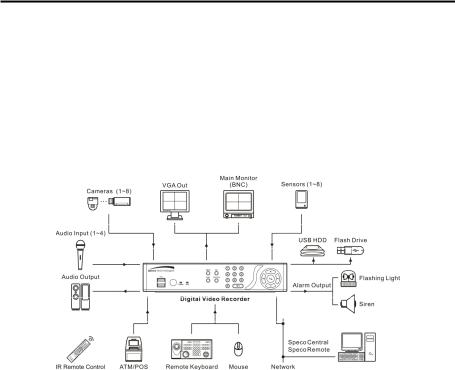
Operation Instruction
Your DVR can be set up for event or time-lapse recording. You can define times to record, and the schedule can change for different days of the week and user defined holidays.
The DVR can be set up to alert you when the hard disk drive is full, or it can be set to record over the oldest video once the disk is full.
Your DVR uses a proprietary encryption scheme making it nearly impossible to alter video.
You can view video and control your DVR remotely by connecting via Ethernet. There is a USB port that can be used to upgrade the system or copy video clips to external hard disk and flash drives.
Figure 1 ─ Typical DVR installation.
NOTE: This manual covers the 4- and 8-channel digital video recorders. The DVRs are identical except for the number of cameras and alarms that can be connected and the number of cameras that can be displayed. For simplicity, the illustrations and descriptions in this manual refer to the 8-camera model.
2
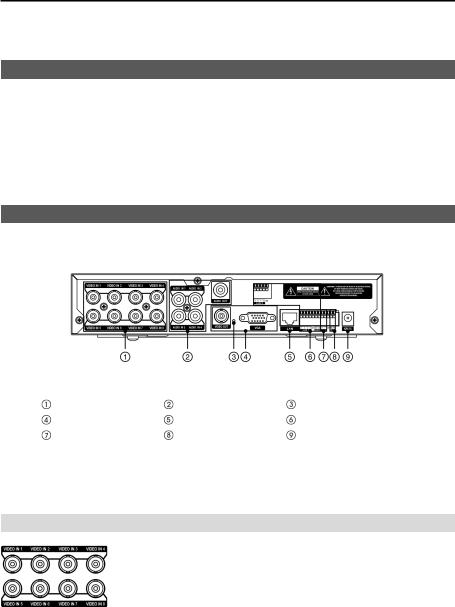
4- & 8-Channel Digital Video Recorder
Chapter 2 ─ Installation
Package Contents
The package contains the following:
Digital Video Recorder
Power Adaptor and Power Cord
Operation Instruction (This Document)
Speco Central Software CD and Operation Instruction
Infrared Remote Control
Required Installation Tools
No special tools are required to install the DVR. Refer to the installation manuals for the other items that make up part of your system.
|
Figure 2 ─ 8-Channel DVR rear panel. |
|
Video Input |
Audio In/Out |
Factory Reset Switch |
Video Out |
Network Port |
Alarm Input/Output |
RS485 Port |
RS232 Port |
Power Cord Connector |
Your DVR can be used with either NTSC or PAL equipment.
NOTE: You cannot mix NTSC and PAL equipment. For example you cannot use a PAL camera and an NTSC monitor.
Video Input
Connect the coaxial cables from the video sources to the BNC Video
In connectors.
3
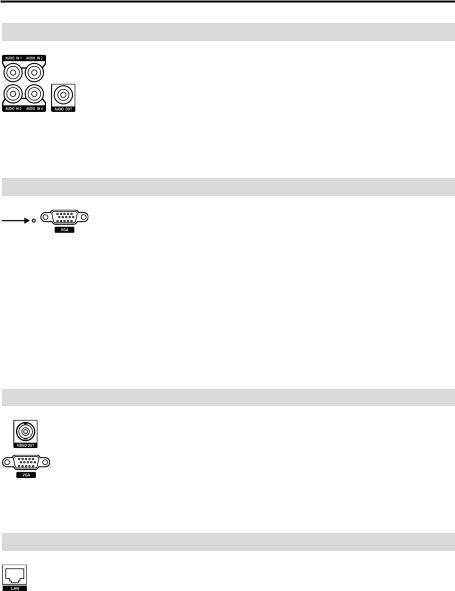
Operation Instruction
Audio In/Out
Your DVR can record audio from up to four sources. Connect the audio sources to Audio In 1, Audio In 2, Audio In 3 and Audio In 4 as needed using RCA jacks. Connect Audio Out to your amplifier.
NOTE: It is the user’s responsibility to determine if local laws and regulations permit recording audio.
NOTE: The DVR does not have amplified audio output, so you will need a speaker with an amplifier. The DVR does not have a pre-amplifier for audio input, so the audio input should be from an amplified source, not directly from a microphone.
Factory Reset Switch
The DVR has a Factory Reset switch to the left of the VGA port on the rear panel. This switch will only be used on the rare occasions that you want to return all the settings to the original factory settings.
CAUTION: When using the Factory Reset, you will lose any settings you have saved.
To reset the unit, you will need a straightened paperclip:
1.Turn the DVR off.
2.Poke the straightened paperclip into the unlabeled hole to the left of the VGA port, and turn the DVR on.
3.Hold the reset switch until the DVR turns on and live monitoring screen appears.
4.Release the reset switch. All of the DVR’s settings are now at the original settings it had when it left the factory.
Video Out
Connect the main monitor to the Video Out connector.
A VGA connector is provided so that you can use a standard, multi-sync computer monitor as your main monitor. Use the cable supplied with your monitor to connect it to the DVR.
NOTE: The Video Out (BNC) and VGA connectors may be connected to individual monitors for simultaneous operation.
Network Port
The DVR can be networked using the 10/100Mb Ethernet connector. Connect a Cat5 cable with an RJ-45 jack to the DVR connector. The DVR can be networked with a computer for remote monitoring, searching, configuration and software upgrades. See Chapter 3 ─Configuration for configuring the Ethernet connections.
CAUTION: The network connector is not designed to be connected directly with cable or wire intended for outdoor use.
4
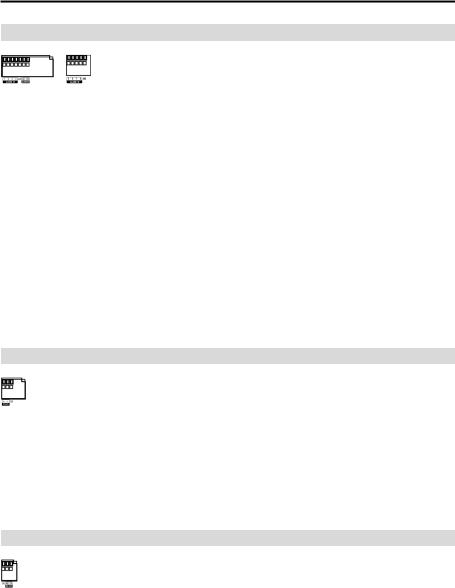
4- & 8-Channel Digital Video Recorder
Alarm Input/Output
NOTE: To make connections on the Alarm Connector Strip, press and hold the button and insert the wire in the hole below the button. After releasing the button, tug gently on the wire to make certain it is connected. To disconnect a wire, press and hold the button above the wire and pull out the wire.
Alarm In 1 to 8 (Alarm-In): You can use external devices to signal the DVR to react to events. Mechanical or electrical switches can be wired to the AI (Alarm-In) and GND (Ground) connectors. The threshold voltage for NC (Normally Closed) is above 4.3V and for NO (Normally Open) is below 0.3V, and it should be stable at least 0.5 seconds to be detected. See Chapter 3 ─Configuration for configuring alarm input.
GND (Ground): Connect the ground side of the Alarm input and/or alarm output to the GND connector.
NOTE: All the connectors marked GND are common.
NO (Normally Open): Connect the device to the COM and NO (Normally Open) connector. NO is a relay output which sinks 1A@30VDC.
Connector Pin Outs: |
Alarm In (1 to 8) |
Alarm Inputs 1 to 8 |
|
GND |
Chassis Ground |
|
COM |
Common |
|
NO |
Alarm Out (Normally Open) |
RS485 Port
The DVR can be controlled remotely by an external device or control system, such as a control keyboard, using RS485 half-duplex serial communications signals. The RS485 connector can also be used to control PTZ (pan, tilt, zoom) cameras or text-in devices. Connect RX+/TX+ and RX-/ TX- of the control system to the + and – (respectively) of the DVR. See Chapter 3 ─ Configuration and the PTZ camera, text-in device or remote controller manufacture’s manual for configuring the RS485 connection.
Connector Pin Outs: |
Master Unit |
|
Slave Unit |
|
|
+ |
→ To |
→ TX+/RX+ |
|
|
– |
→ To |
→ TX-/RX- |
|
|
GND |
→ To |
→ GND |
|
RS232 Port
An RS232 port is provided to connect remote control devices such as a control keyboard. PTZ cameras or text-in devices can also be connected to the RS232 port. See Chapter 3 ─Configuration and the PTZ camera, text-in device or remote controller manufacturer’s manual for configuring the RS232 connection.
5
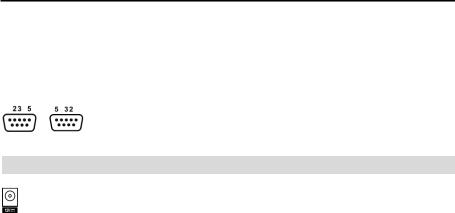
Operation Instruction
Connector Pin Outs: |
Master Unit |
|
|
Slave Unit |
|
|
RX |
→ To |
→ |
TXD |
|
|
TX |
→ To |
→ |
RXD |
|
|
GND |
→ To |
→ |
GND |
|
NOTE: Refer to the following for pin-out details for the 9-pin connector of the slave unit.
|
|
Pin 2 |
RXD (Receive Data) |
|
|
Pin 3 |
TXD (Transmit Data) |
Male |
Female |
Pin 5 |
GND (Ground) |
Power Cord Connector
Connect the connector from the adaptor to the DVR, and connect the AC power cord to the adaptor and then to the wall outlet.
WARNING: ROUTE POWER CORDS SO THAT THEY ARE NOT A TRIPPING HAZARD. MAKE CERTAIN THE POWER CORD WILL NOT BE PINCHED OR ABRADED BY FURNITURE. DO NOT INSTALL POWER CORDS UNDER RUGS OR CARPET.
THE POWER CORD HAS A GROUNDING PIN. IF YOUR POWER OUTLET DOES NOT HAVE A GROUNDING PIN RECEPTACLE, DO NOT MODIFY THE PLUG. DO NOT OVERLOAD THE CIRCUIT BY PLUGGING TOO MANY DEVICES IN TO ONE CIRCUIT.
CAUTION: Ensure the DVR is not near any heat source that could cause overheating.
CAUTION: The DVR does not have an internal fan so leave a clearance of at least 6 inches near ventilation hole areas on each side panel of the unit for proper ventilation.
Your DVR is now ready to operate. Refer to Chapter 3 ─Configuration and Chapter 4 ─Operation.
6
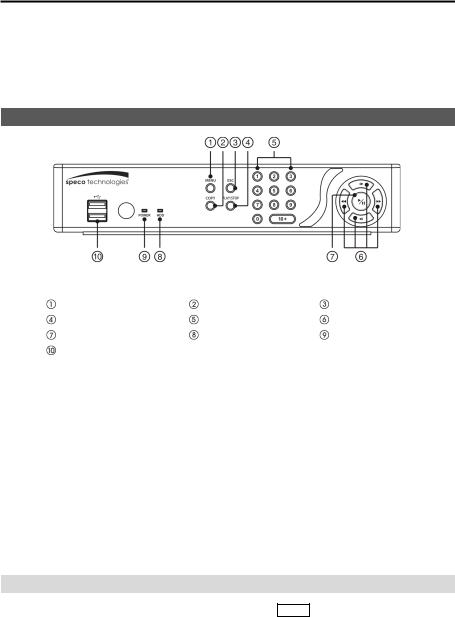
4- & 8-Channel Digital Video Recorder
Chapter 3 ─ Configuration
NOTE: Your DVR should be completely installed before proceeding. Refer to Chapter 2 ─ Installation.
Front Panel Controls
|
Figure 3 ─ DVR front panel. |
|
Menu Button |
Copy Button |
Esc Button |
Play/Stop Button |
Camera Buttons |
Arrow Buttons |
Play/Pause Button |
HDD LED |
Power LED |
USB Port |
|
|
The front panel looks and operates much like a VCR combined with a multiplexer. The following describes each button and control. Take a few minutes to review the descriptions. You will use these to initially set up your DVR and for daily operations.
NOTE: A separate Alarm button on the front panel is not provided. Pressing any button on the front panel resets alarm output including the internal buzzer when the alarm is activated. However, when you are in the menu or PTZ mode, you have to exit the menu or PTZ mode first to reset alarm output.
NOTE: The infrared sensor is just to the right of the USB ports. Make certain that nothing blocks the sensor, or the remote control will not function properly.
NOTE: When you use wireless communication devices (such as Wi-Fi or Bluetooth) near the DVR, the remote control might not function properly.
NOTE: You can also use a USB mouse (not supplied) to navigate through the screens and menus much like you would on a computer.
Menu Button
In the Live Monitoring mode and Search mode, pressing the MENU button displays the menu icons at the top of the screen.
7
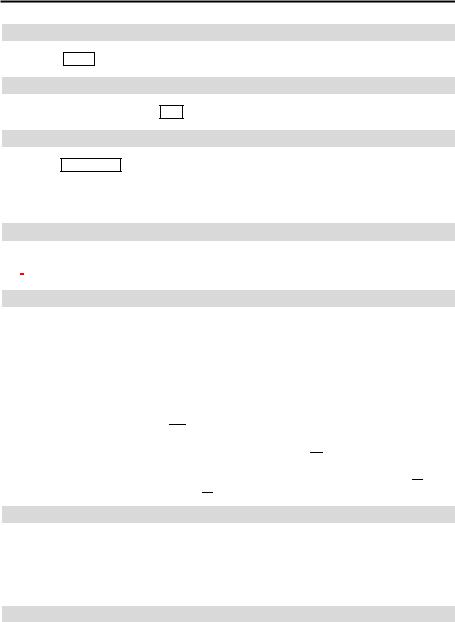
Operation Instruction
Copy Button
Pressing the COPY button allows you to copy video clips.
Esc Button
During menu setup, pressing the ESC button closes the current menu or setup dialog box.
Play/Stop Button
Pressing the PLAY/STOP button enters the playback mode, and pressing the button again exits the playback mode. When entering the playback mode, video is paused. Pressing the  (Play/Pause) button plays back video at regular speed. The screen displays
(Play/Pause) button plays back video at regular speed. The screen displays  when the DVR is in the Pause mode and the screen displays
when the DVR is in the Pause mode and the screen displays  when the DVR is playing back video.
when the DVR is playing back video.
Camera Buttons
Pressing the individual camera buttons will cause the selected camera to display full screen. Buttons 1 to 9 are also used to enter passwords.
Arrow Buttons
These buttons are used to navigate through menus and GUI. You can also use them to change numbers by highlighting a number in the menu and using the Up and Down arrow buttons to increase or decrease the number’s value.
When in the PIP display format, pressing the Up and Down arrow buttons moves the position of the small screen counter-clockwise and clockwise, and pressing the Left and Right buttons changes the PIP screen size.
In the playback mode, pressing the  button plays video backward at high speed. Pressing the button again toggles the playback speed from
button plays video backward at high speed. Pressing the button again toggles the playback speed from  ,
,  and
and  , and the screen displays
, and the screen displays  ,
,  and
and  respectively. While playing video, pressing the
respectively. While playing video, pressing the  button plays video forward at high speed. Pressing the button again toggles the playback speed from
button plays video forward at high speed. Pressing the button again toggles the playback speed from  ,
,  and
and  , and
, and
the screen displays  ,
,  and
and  respectively. When in the pause mode, pressing the
respectively. When in the pause mode, pressing the  button moves to the next image and pressing the
button moves to the next image and pressing the  button moves to the previous image.
button moves to the previous image.
Play/Pause Button
In the live monitoring mode, pressing the  button freezes the current screen and the screen displays
button freezes the current screen and the screen displays  icon. When in the playback mode, pressing the
icon. When in the playback mode, pressing the  button pauses playing video.
button pauses playing video.
Pressing the  button selects a highlighted item or completes an entry that you have made during system setup.
button selects a highlighted item or completes an entry that you have made during system setup.
HDD LED
The HDD LED flickers when the DVR is recording or searching video on the hard disk drive.
8
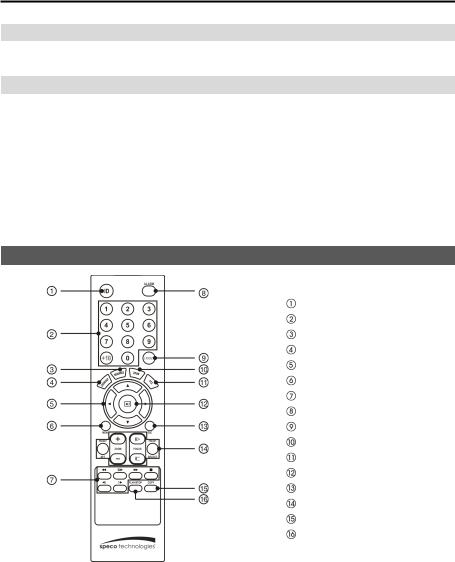
4- & 8-Channel Digital Video Recorder
Power LED
The POWER LED is lit when the unit is On.
USB Port
A USB port on the front panel is provided to connect external hard disk or flash drives for video clip copying or system upgrades. Position external drives close enough to the DVR so that you can make the cable connections, usually less than 6 feet. Use the USB cable provided with the hard disk drive to connect it to the DVR.
A USB mouse (not supplied) can be connected to the USB port. You can use the mouse to navigate through the screens and menus much like you would on a computer.
A USB to Serial converter can be connected to the USB port. Multiple text-in devices can be used with a USB to Serial converter.
Remote Control Buttons
ID Button
Camera Buttons
Sequence Button
Login/Logout Button
Arrow Buttons
Menu Button
Playback Buttons
Alarm Button
Layout Button
Zoom Button
PTZ Button
Enter Button
Esc Button
PTZ Control Buttons
Copy Button
Play/Stop Button
Figure 4 ─ Infrared remote control.
9
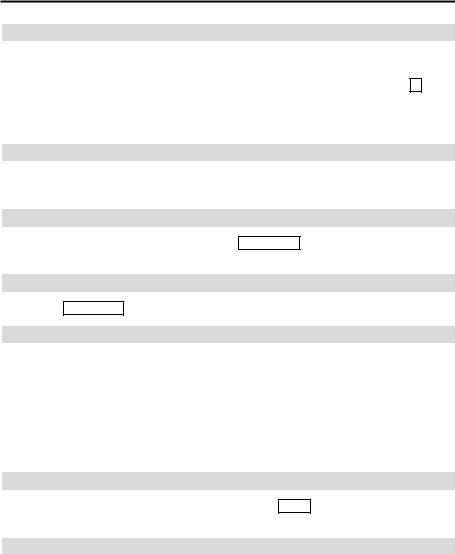
Operation Instruction
ID Button
If a DVR System ID is set to 0, the infrared remote control will control that DVR without any additional operations. (Refer to the System Information setup screen in this chapter for further information on setting the System ID.) If the system ID is 1 to 16, you must to press the ID button and then press the number button (1 to 16 (+10 & 6)) in order to control that DVR. If the System ID of two or more DVRs is set to 0, those DVRs will react to the infrared remote control at the same time.
Camera Buttons
Pressing the individual camera buttons will cause the selected camera to display full screen. Buttons 1 to 9 are also used to enter passwords.
Sequence Button
When in the Live Monitoring mode, pressing the SEQUENCE button displays live channels sequentially.
Login/Logout Button
Pressing the LOGIN/OUT button displays the Login or Logout screen.
Arrow Buttons
These buttons are used to navigate through menus and GUI. You can also use them to change numbers by highlighting a number in the menu and using the Up and Down arrow buttons to increase or decrease the number’s value.
When in the PIP display format, pressing the Up and Down arrow buttons moves the position of the small screen counter-clockwise and clockwise.
Pressing the Left and Right buttons moves through screen pages in the Live Monitoring mode and Search mode.
Menu Button
In the Live Monitoring mode and Search mode, pressing the MENU button displays the menu icons at the top of the screen.
Playback Buttons
Rewind: Pressing the  button plays video backward at high speed. Pressing the button again toggles the playback speed from
button plays video backward at high speed. Pressing the button again toggles the playback speed from  ,
,  and
and  .
.
Play/Pause: Pressing the  button plays back video at regular speed. The screen displays
button plays back video at regular speed. The screen displays  when the DVR is in the Pause mode and the screen displays
when the DVR is in the Pause mode and the screen displays  when the DVR is playing back video.
when the DVR is playing back video.
Fast Forward: Pressing the  button plays video forward at high speed. Pressing the button again toggles the playback speed from
button plays video forward at high speed. Pressing the button again toggles the playback speed from  ,
,  and
and  .
.
10
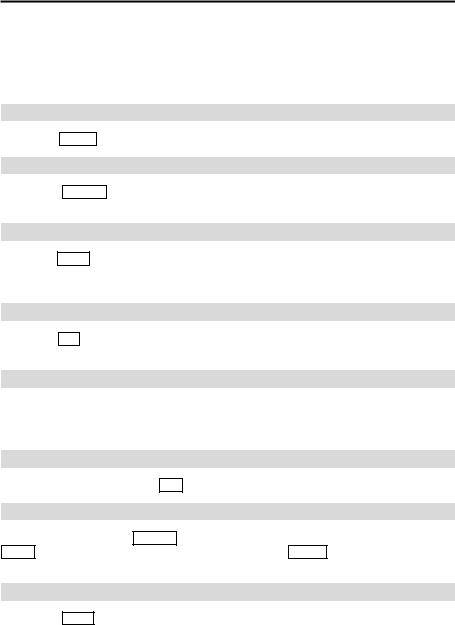
4- & 8-Channel Digital Video Recorder
Stop: Pressing the  button stops playback and enters the Live Monitoring mode.
button stops playback and enters the Live Monitoring mode.
Backward: When in the pause mode, pressing the  button moves to the previous image.
button moves to the previous image.
Forward: When in the pause mode, pressing the  button moves to the next image.
button moves to the next image.
In the Live Monitoring mode, pressing any playback button enters to the Search mode.
Alarm Button
Pressing the ALARM button resets the DVR’s outputs including the internal buzzer during an alarm.
Layout Button
Pressing the LAYOUT button toggles between different display formats. The available formats are: 3x3, 1P7, 1P5, 2x2 and PIP.
Zoom Button
Pressing the ZOOM button zooms the current image on the screen. A PIP with a rectangle temporarily displays showing what area of the screen has been enlarged. You can use the arrow buttons to move the rectangle to another area.
PTZ Button
Pressing the PTZ button enters the PTZ (Pan/Tilt/Zoom) mode which allows you to control properly configured cameras.
Enter Button
The  (Enter) button selects a highlighted item or completes an entry that you have made during system setup. This button is also used to enter the Cameo mode in the Live Monitoring mode or Search mode (8-ch Model Only).
(Enter) button selects a highlighted item or completes an entry that you have made during system setup. This button is also used to enter the Cameo mode in the Live Monitoring mode or Search mode (8-ch Model Only).
Esc Button
During menu setup, pressing the ESC button closes the current menu or setup dialog box.
PTZ Control Buttons
While in the PTZ mode, the PRESET buttons are used to save Presets and load a Preset View, the ZOOM buttons are used to Zoom In and Zoom Out, and the FOCUS buttons are used for Near Focus and Far Focus.
Copy Button
Pressing the COPY button allows you to copy video clips.
11
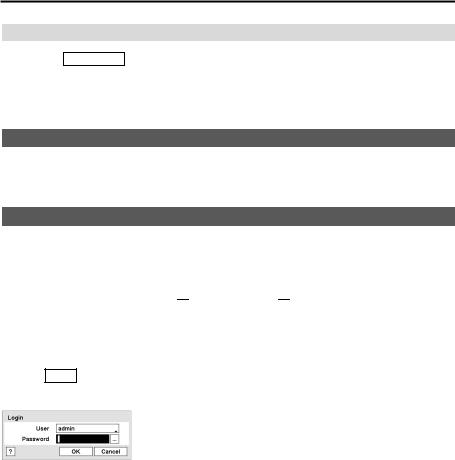
Operation Instruction
Play/Stop Button
Pressing the PLAY/STOP button enters the playback mode, and pressing the button again exits the playback mode. When entering the playback mode, video is paused. Pressing the  button plays back video at regular speed. The screen displays
button plays back video at regular speed. The screen displays  when the DVR is in the Pause mode and the screen displays
when the DVR is in the Pause mode and the screen displays  when the DVR is playing back video.
when the DVR is playing back video.
Turning on the Power
Connecting the power cord to the DVR turns on the unit. The unit takes approximately 60 seconds to initialize.
Initial Unit Setup
Before using your DVR for the first time, you will want to establish the initial settings. This includes items such as time and date, display language, camera, audio, remote control, record mode, network and password. Your DVR can be set up using various screens and dialog boxes.
Throughout the screens you will see  . Highlighting the
. Highlighting the  and pressing the
and pressing the  (Play/Pause) button gives you the opportunity to reset that screen to its default settings. After you are finished with any setup screen, you can highlight Save and press the
(Play/Pause) button gives you the opportunity to reset that screen to its default settings. After you are finished with any setup screen, you can highlight Save and press the  button to save the changes and exit the screen. If you do not wish to save the changes, highlight Cancel and press the
button to save the changes and exit the screen. If you do not wish to save the changes, highlight Cancel and press the  button to exit the screen.
button to exit the screen.
Press the MENU button or move the mouse pointer to the top of the screen and then select  (Login) in the Live Monitoring menu to enter the setup screens. The Login screen appears.
(Login) in the Live Monitoring menu to enter the setup screens. The Login screen appears.
Figure 5 ─ Login screen.
Select a User and enter the password by pressing the appropriate combination of Camera number buttons and then the  button. There is no default password when logging in the admin user for the first time. If you do not know the password, click the
button. There is no default password when logging in the admin user for the first time. If you do not know the password, click the  button for guidance.
button for guidance.
NOTE: To assure the secure management of the system, setting up a password is strongly recommended.
NOTE: If you cannot use the front panel buttons, click the  button using the mouse to enter a password, and the virtual keyboard displays. See instructions below for using the virtual keyboard.
button using the mouse to enter a password, and the virtual keyboard displays. See instructions below for using the virtual keyboard.
12
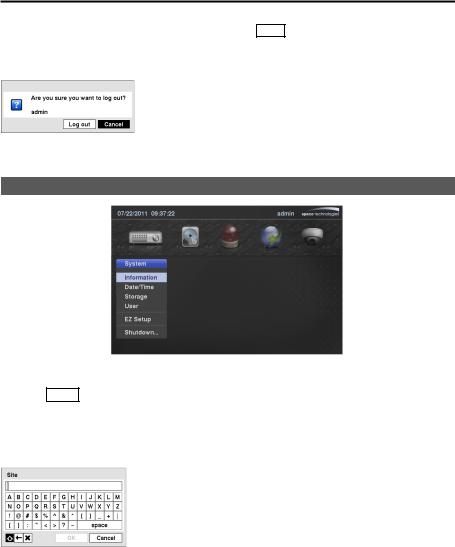
4- & 8-Channel Digital Video Recorder
NOTE: To log the user out of the system, press the MENU button on the front panel or move the mouse pointer to the top of the screen and then select  (Logout) in the Live Monitoring menu. The Logout screen displays asking you to confirm whether or not you want to log out the current user.
(Logout) in the Live Monitoring menu. The Logout screen displays asking you to confirm whether or not you want to log out the current user.
Figure 6 ─ Logout screen.
Setup Screen
Figure 7 ─ Setup screen.
Press the MENU button on the front panel or move the mouse pointer to the top of the screen and then select  (Setup) in the Live Monitoring menu to enter the setup screen.
(Setup) in the Live Monitoring menu to enter the setup screen.
While setting up the DVR, there will be many opportunities to enter names and titles. When making these entries, a Virtual Keyboard will appear.
Use the arrow keys to highlight the character you want in the name or title and press the  button. That character appears in the title bar and the cursor moves to the next position. Pressing
button. That character appears in the title bar and the cursor moves to the next position. Pressing  toggles between the upper and lower case keyboards,
toggles between the upper and lower case keyboards,  backspaces, and
backspaces, and  deletes entered characters. You can use up to 31 characters including spaces in your title.
deletes entered characters. You can use up to 31 characters including spaces in your title.
Special characters can be created using ^ and a capital letter; e.g. ^J for NL (New Line), ^M for CR (Carriage Return). Special characters are commonly used by text input devices and will be useful when performing Text-In Searches.
13
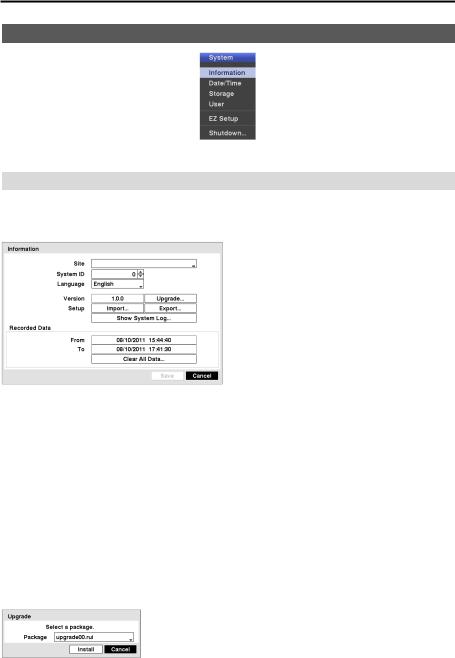
Operation Instruction
System Setup
Figure 8 ─ System menu.
Information
Highlight Information in the System menu and press the  button. The Information setup screen appears.
button. The Information setup screen appears.
In the Information screen, you can name the site location, assign a System ID number, select the language the screens are displayed in, display software version number, upgrade the software, show the System Log, display recorded time data, and clear all data.
Highlight the Site box and press the  button. A virtual keyboard appears that you can use to enter a Site Name. Once you have entered your title, highlight Close and press the
button. A virtual keyboard appears that you can use to enter a Site Name. Once you have entered your title, highlight Close and press the  button.
button.
Figure 9 ─ Information setup screen.
Highlight the box beside System ID and press the  button. Change the number by highlighting it and using the Up and Down arrow buttons to increase and decrease the number from 0 to 99.
button. Change the number by highlighting it and using the Up and Down arrow buttons to increase and decrease the number from 0 to 99.
NOTE: The System ID number is used to identify the unit when it is connected with other DVRs through the RS485 port. You cannot use the same ID number for two or more DVRs that are in the same RS485 network. It is possible to have multiple DVRs with System ID 0 that are in the same area as long as they are not part of an RS485 network. If this is the case, all will be controlled at the same time when using the infrared remote control.
Highlight the box beside Language and press  button. A drop-down menu displays the available languages. Highlight the desired language and press the
button. A drop-down menu displays the available languages. Highlight the desired language and press the  button.
button.
The box beside Version displays the software version of the DVR.
To upgrade the software, connect a USB device containing the upgrade package file to the DVR. Highlight Upgrade… and press the  button. The Upgrade screen appears.
button. The Upgrade screen appears.
The screen displays the upgrade package file names that are available. The “.rui” indicates that the file is for software upgrades. Select the desired file and press the  button.
button.
14
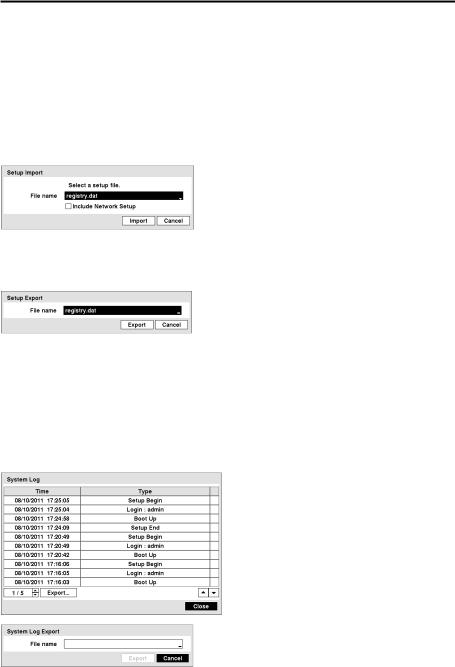
4- & 8-Channel Digital Video Recorder
Highlighting the Install button and pressing the  button will install the selected software package. Highlighting the Cancel button and pressing the
button will install the selected software package. Highlighting the Cancel button and pressing the  button will close the window without upgrading the software. If the upgrade package file is not installed on the DVR properly, you will get an error message.
button will close the window without upgrading the software. If the upgrade package file is not installed on the DVR properly, you will get an error message.
CAUTION: The system restarts automatically after completing the upgrade, and it takes approximately one minute to restart. Do NOT remove the USB device until the DVR restarts, otherwise the system upgrade will not be completed properly.
CAUTION: The USB device must be FAT16 or FAT32 format.
You can import saved DVR settings or export the current DVR settings. To import saved DVR settings, connect the USB device containing the setup file (.dat) to the DVR. Highlight Setup – Import… and press the  button.
button.
Select the desired setup file and press the Import button to import the selected settings and change the DVR settings accordingly. Highlight Include Network Setup and press the  button to toggle between On and Off. When set to Off, the network settings will not be changed.
button to toggle between On and Off. When set to Off, the network settings will not be changed.
To export the current DVR settings, connect the USB device to the DVR. Highlight Setup – Export… and press the  button.
button.
Highlight the box beside File name and press the  button. A virtual keyboard allows you to enter the file name. Selecting Export will save the current settings in .dat file format on the USB device.
button. A virtual keyboard allows you to enter the file name. Selecting Export will save the current settings in .dat file format on the USB device.
NOTE: Even after changing the DVR settings by importing saved settings, the time-related settings (Date/Time, Time Zone and Daylight Saving Time) will NOT be changed.
CAUTION: The USB device must be FAT16 or FAT32 format.
Highlight Show System Log… and press the  button to display the System Log.
button to display the System Log.
The System Log screen lists system activities (up to 5,000 from the latest) that have occurred along with the time and date. The  icon will be displayed in the last column for system activities of the remote site. You can scroll through the log pages by using the Up and Down arrows, or you can go directly to a log page by entering the log page number in the box at the bottom left of the screen. Highlight Close and press the
icon will be displayed in the last column for system activities of the remote site. You can scroll through the log pages by using the Up and Down arrows, or you can go directly to a log page by entering the log page number in the box at the bottom left of the screen. Highlight Close and press the  button to exit the screen.
button to exit the screen.
To export the system log information, connect the USB device to the DVR. Highlight Export… and press the  button.
button.
15
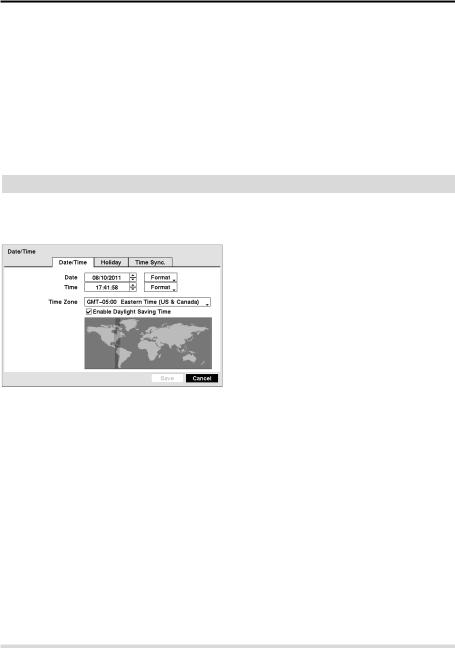
Operation Instruction
Highlight the box beside File name and press the  button. A virtual keyboard allows you to enter the file name. Selecting Export will save the log information in .txt file format on the USB device.
button. A virtual keyboard allows you to enter the file name. Selecting Export will save the log information in .txt file format on the USB device.
NOTE: When opening the saved .txt file, setting to the proper character encoding and using fixed width fonts will be required to read the file properly.
The box beside Recorded Data – From / To displays the time information of recorded data.
Highlighting Clear All Data… and pressing the  button will clear all video data. You will be asked to verify that you wish to clear all data before the DVR erases the video data. Clear All Data… will not clear the System Log.
button will clear all video data. You will be asked to verify that you wish to clear all data before the DVR erases the video data. Clear All Data… will not clear the System Log.
Date/Time
Highlight Date/Time in the System menu and press the  button. The Date/Time setup screen appears.
button. The Date/Time setup screen appears.
Highlight the first box beside Date and press the  button. The individual sections of the date will highlight. Use the Up and Down arrow buttons to change the number. Use the Left and Right arrow buttons to move between month, date and year. Once you have the correct date, press the
button. The individual sections of the date will highlight. Use the Up and Down arrow buttons to change the number. Use the Left and Right arrow buttons to move between month, date and year. Once you have the correct date, press the  button.
button.
Highlight the Format box beside Date and press the  button. Select from the three available date formats and press the
button. Select from the three available date formats and press the  button to save your
button to save your
selected format.
Figure 10 ─ Date/Time setup screen.
Highlight the first box beside Time and press the  button. The individual sections of the time will highlight. Use the Up and Down arrow buttons to change the number. Use the Left and Right arrow buttons to move between hour, minutes and seconds. Once you have the correct time, press the
button. The individual sections of the time will highlight. Use the Up and Down arrow buttons to change the number. Use the Left and Right arrow buttons to move between hour, minutes and seconds. Once you have the correct time, press the  button.
button.
Highlight the Format box beside Time and press the  button. Select from the three available time formats and press the
button. Select from the three available time formats and press the  button to save your selected format.
button to save your selected format.
NOTE: The clock will not start running until you have highlighted Save and pressed the  button.
button.
Highlight the box beside Time Zone and press the  button. Select your time zone from the list and press the
button. Select your time zone from the list and press the  button.
button.
NOTE: The Time Zone can also be selected on the map below by pressing the Left and Right buttons or scrolling the mouse wheel up and down.
Highlight Enable Daylight Saving Time and press the  button. Pressing the
button. Pressing the  button toggles between On and Off.
button toggles between On and Off.
16
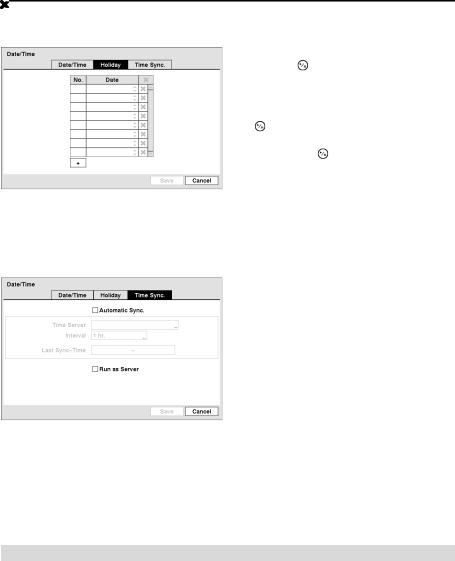
4- & 8-Channel Digital Video Recorder
Highlight the Holiday tab, and the Holiday setup screen appears.
|
You can set up holidays by highlighting + and |
|
pressing the button. The current date |
|
appears. |
|
Highlight the month and day and change them |
|
by using the Up and Down arrow buttons. Press |
|
the button to add the date. Dates can be |
|
deleted by highlighting the beside the date |
|
and pressing the button. |
|
NOTE: Holidays that do not fall on the same |
|
date each year should be updated once the |
Figure 11 ─ Holiday setup screen. |
current year’s holiday has passed. |
|
|
|
|
Highlighting the Time Sync. tab causes the Time Sync. setup screen to display. You can set up time synchronization between the DVR and standard time servers that are available in most time zones and countries, or between the DVR and another DVR.
Highlight the box beside Automatic Sync. and press the  button. This toggles between On and Off.
button. This toggles between On and Off.
Highlight the box beside Time Server and press the  button. A virtual keyboard appears that you can use to enter the IP address or domain name of the time server.
button. A virtual keyboard appears that you can use to enter the IP address or domain name of the time server.
NOTE: You can use the domain name instead of IP address if you already set up the DNS Server when setting up the LAN.
Figure 12 ─ Time Sync. setup screen.
Highlight the box beside Interval and press the  button. Set the time interval for synchronization from 30 minutes to 1 day at various time intervals.
button. Set the time interval for synchronization from 30 minutes to 1 day at various time intervals.
Last Sync-Time displays the last time the DVR was synchronized with the time server.
Highlight Run as Server and press the  button. Pressing the
button. Pressing the  button toggles between On and Off. When it is On, the DVR you are setting up will run as a time server.
button toggles between On and Off. When it is On, the DVR you are setting up will run as a time server.
Storage
Highlight Storage in the System menu and press the  button. The Storage setup screen appears and displays information about the DVR’s storage devices.
button. The Storage setup screen appears and displays information about the DVR’s storage devices.
17
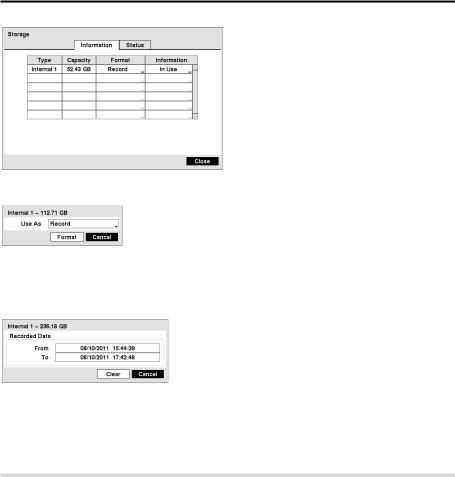
Operation Instruction
The information in the Type column describes the storage device.
The capacity of the storage device is displayed in the Capacity column.
The Format column displays whether the device is used for recording (Record) or not (Not Using). Not formatted indicates the device is not formatted.
Figure 13 ─ Storage Information setup screen.
Highlight the box in the Format column for the desired storage device and press the  button. You will be able to format the device for recording. When selecting Not Using from Use As and highlighting the Format button, the device will not be used for recording.
button. You will be able to format the device for recording. When selecting Not Using from Use As and highlighting the Format button, the device will not be used for recording.
NOTE: The DVR does NOT support USB hard disk drives with a version lower than 2.0.
The Information column displays whether the device is being used or not. Other indicates the device has been used for another DVR.
Highlight the box in the Information column for the desired storage device and press the  button. The box beside Recorded Data – From / To displays the time information of recorded data.
button. The box beside Recorded Data – From / To displays the time information of recorded data.
Highlighting Clear and pressing the  button will clear all video data. You will be asked to verify that you wish to clear all data before the DVR erases the video data.
button will clear all video data. You will be asked to verify that you wish to clear all data before the DVR erases the video data.
CAUTION: Do NOT disconnect the USB cable or the power from the device while copying video clips. If the USB cable is disconnected while copying video clips, archived data might be lost.
Highlight the Status tab, and the Storage Status setup screen displays.
18
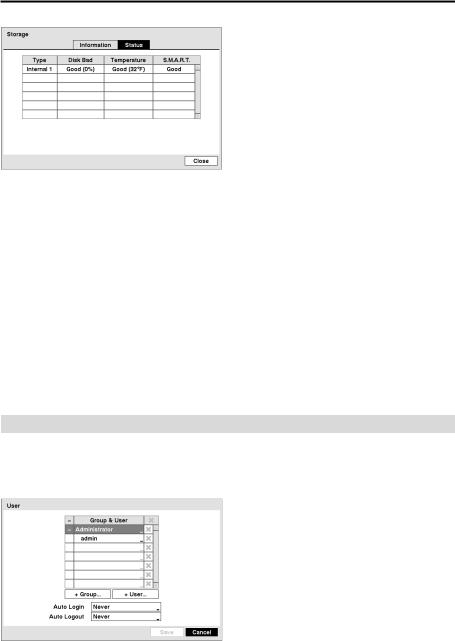
4- & 8-Channel Digital Video Recorder
The Type column displays the type of storage device.
The Disk Bad column displays the percentage of bad sectors.
Not formatted – The device is not formatted. Good – Less than user-defined percentage of bad
disk sections is damaged.
Bad – More than user-defined percentage of bad disk sections is damaged.
Figure 14 ─ Storage Status setup screen.
The Temperature column displays the temperature of the storage device.
Good – The temperature does not exceed the user-defined temperature threshold.
Bad – The temperature exceeds the user-defined temperature threshold.
N/A – The DVR cannot read the temperature.
The S.M.A.R.T. column displays “Good”, “Bad” or “N/A”, depending on storage conditions.
Good – The storage condition is normal.
Bad – Data cannot be written on or read from the storage device.
N/A – Storage conditions are normal, however, the S.M.A.R.T. monitoring is not working or supported.
NOTE: When the S.M.A.R.T. displays Bad, the screen displays a message box. Once the “Bad” message displays, replacing the hard disk drive is recommended, usually within 24 hours.
NOTE: Temperature and S.M.A.R.T. information will be available only for internal hard disk drives supporting the SMART (Self-Monitoring Analysis and Reporting Technology) monitoring program.
User
Highlight User in the System menu and press the  button. The User setup screen displays the authorized groups and users. You can add and delete groups and users. When adding a group, you can assign authority levels to the group.
button. The User setup screen displays the authorized groups and users. You can add and delete groups and users. When adding a group, you can assign authority levels to the group.
Figure 15 ─ User setup screen.
The +/- column is used to collapse and expand user groups. If there is a + or – in this column, it indicates the item is a Group Name. If there is a – in front of the Group Name, it indicates that the group has been “expanded” and all of the User Names within that group are displayed below the Group Name. If there is a + in front of the Group Name, it indicates that the group has been “collapsed” and all of the User Names within that group are hidden. To collapse or expand a group, highlight the +/- column in front of the desired group and press the  button.
button.
19
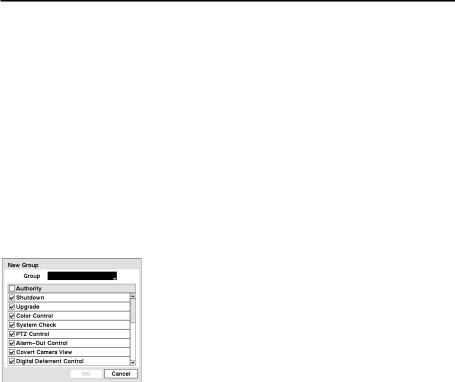
Operation Instruction
Highlighting a Group Name and pressing the  button allows you to change the authority levels assigned to the group.
button allows you to change the authority levels assigned to the group.
CAUTION: Write down the new password and save it in a secure place. If the password is forgotten, the unit must be reset using the Factory Reset Button and all data settings will be lost.
Highlighting a User Name and pressing the  button allows you to add or change the password assigned to that user. You can also change the group to which the user is assigned.
button allows you to add or change the password assigned to that user. You can also change the group to which the user is assigned.
The  column can be used to delete a User Name or an entire Group. If the
column can be used to delete a User Name or an entire Group. If the  is grayed out, that Group or User cannot be deleted. Highlight the
is grayed out, that Group or User cannot be deleted. Highlight the  and press the
and press the  button. You will be asked to confirm that you want to delete the User or Group. To delete the User currently logged into the DVR on a local system or a PC running Speco Central, log the user out of the system first and then delete the user.
button. You will be asked to confirm that you want to delete the User or Group. To delete the User currently logged into the DVR on a local system or a PC running Speco Central, log the user out of the system first and then delete the user.
To add a Group, highlight the + Group… box and press the  button. A virtual keyboard appears allowing you to enter the Group name.
button. A virtual keyboard appears allowing you to enter the Group name.
You can use up to 15 characters including spaces in the group name. Enter the name and assign authority levels to the group. Highlighting the Authority box and pressing the  button will toggle between all authority levels being turned On and Off.
button will toggle between all authority levels being turned On and Off.
Highlighting the individual authority level boxes and pressing the  button will toggle between that authority level being turned On and Off. The authority levels that can be turned On and Off are:
button will toggle between that authority level being turned On and Off. The authority levels that can be turned On and Off are:
Shutdown – The user can shut the system down on a local system.
Upgrade – The user can upgrade the software on a local system or a PC running Speco Central.
Color Control – The user can control brightness, contrast, hue and saturation for cameras on a local system or a PC running Speco Central.
System Check – The user can view the remote system status or check the remote system status as a batch process on a PC running Speco Central.
PTZ Control – The user can control the PTZ camera on a local system or a PC running Speco Central.
Alarm-Out Control – The user can reset the DVR’s outputs including the internal buzzer during an alarm by pressing any button on the front panel or remote control on a local system or alarm-out control button on a PC running Speco Central.
Covert Camera View – The user can view video from cameras set as Covert while in the Live Monitoring or Search mode on a local system or a PC running Speco Central.
Digital Deterrent Control – The user can trigger the Digital Deterrent sound manually by selecting  (Digital Deterrent) in the Live Monitoring menu and Search menu on a local system.
(Digital Deterrent) in the Live Monitoring menu and Search menu on a local system.
Search – The user can access the Search mode on a local system or a PC running Speco Central.
Clip-Copy – The user can copy video clips on a local system or a PC running Speco Central.
Setup – The user without Setup authority cannot establish any system settings excluding system shutdown and logout on a local system or a PC running Speco Central.
System Time Change – The user can change the system date and time on a local system or a PC running Speco Central.
Data Clear – The user can clear all video data or format disks on a local system or a PC running Speco Central.
20
